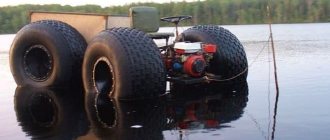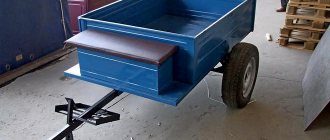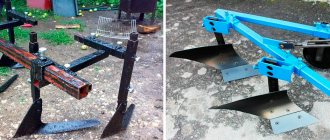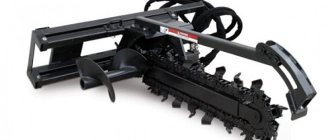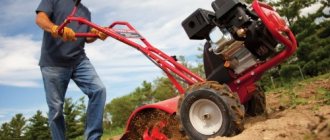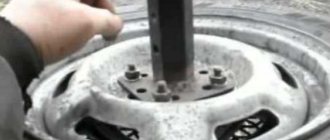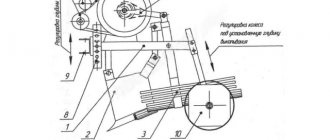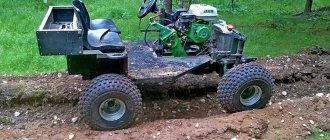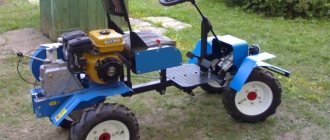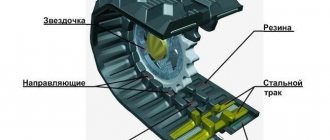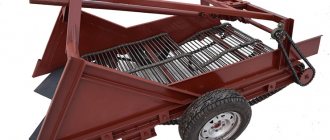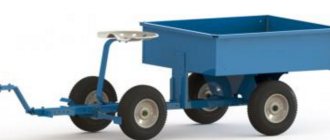NEVA walk-behind tractors have a number of advantages that set them apart from their analogues. One of these advantages is wheel separation. This function, as a rule, is not found in other units, with the exception of premium segment models. The separation of the wheels of the walk-behind tractor is used for ease of control when performing a number of agrotechnical and business operations. The essence of this function is the ability to disable the gearbox axle shaft on which the wheel, cutter or lug is located. This allows you to deploy the unit almost in one place with minimal effort for users. The function can be used during cultivation or plowing. For example, when the user reaches the end of a row, he needs to turn the machine around to continue working. In this situation, he presses the release lever and turns the equipment 180° in five seconds. In the same way, you can turn the unit with a snow blower, shovel, broom, mower or cart installed.
Design and purpose of a walk-behind tractor differential
The main purpose of the walk-behind tractor differential is to distribute power more evenly between the wheels of the walk-behind tractor.
The differential will be especially useful when turning. To turn a walk-behind tractor, you usually need to put in a lot of effort, especially if the equipment has lugs and attachments. The differential allows for easier turning due to faster wheel rotation. Thanks to it, the wheels rotate faster than the one that occurs only due to the axle. For different models of walk-behind tractors, differentials have their own design features and differences. For example, for light Neva walk-behind tractors, differentials with a small wheel rotation angle (240°) are used. Also, due to the transverse groove, it has little strength; strong friction of the parts is observed inside the mechanism.
Motoblocks from Salut are equipped with differentials of a more complex design. They are distinguished by greater mass and wheel rotation angle (about 330°). The extension has bearings, which reduces the effort when turning.
For Farmer brand walk-behind tractors, differentials consist of two clutches, and control is carried out using levers on the steering wheel.
How to use wheel disengagement
The rules for using the axle release are described in detail in the Product Operation Manual.
However, for the convenience of readers, we provide instructions in this article. And so, in order to use the wheel release mechanism of the NEVA walk-behind tractor, you must do the following: • stop the unit by releasing the clutch lever; • press the axle release lever (the lever is pressed easily with little effort); • press the clutch lever and turn the equipment around; • after completing the turn, release the clutch lever and stop the walk-behind tractor; • release the axle release lever. Please note that the release lever must not be pressed when the walk-behind tractor is moving and the clutch lever is pressed, because this may damage the release mechanism splines in the gearbox. It is also prohibited to use the axle release when the unit is moving with the trolley.
How to make a differential for a walk-behind tractor with your own hands?
To avoid unnecessary financial costs, you can make a homemade differential. This process is not complicated, and the availability of freely available drawings and various materials makes the task even easier.
The manufacturing process looks like this:
- using a lathe, a part is turned according to the drawings;
- the flange is turned out and carefully welded to a part of the metal pipe;
- To make a differential, use only high-quality steel blanks, since this part is subject to high loads.
Distinctive features
The power take-off shaft is a mechanism that ensures stable transmission of the energy generated by the engine to the working elements of attachments.
Most modern models are equipped with this element. It is located at the rear of the car. Sometimes the PTO is supplemented by a differential located in the front part.
The main tasks of the power take-off shaft are as follows::
- Starts mechanical components in attachments. In this case, it is connected to the agricultural machine directly or through additional elements, including a gearbox, cardan shaft and V-belt drives. This is the main purpose of the PTO, since thanks to this the unit can perform additional functions.
- Starts the hydraulic system of towed equipment. The PTO acts on the equipment pump. For this purpose, the shaft is used less frequently, since farmers do not often use walk-behind tractors in combination with a hydraulic system.
Characteristics and types of hubs for walk-behind tractors
A hub for a walk-behind tractor is needed to install pneumatic wheels or steel lugs.
Walk-behind tractor wheel hubs come in 3 main types:
- differential hub with unlocking;
- semi-differential hub (simplified version of the previous one);
- the hub is ordinary.
A differential hub for a walk-behind tractor is considered a universal part and is needed in cases where the walk-behind tractor is not equipped with a wheel unlocking system, and turning the vehicle around causes difficulties. The hub with bearings greatly facilitates control and improves maneuverability. To perform a turn, you just need to remove the lock from the lock of the required wheel.
Based on the diameter of the hub, they are classified into:
- hexagonal (24 and 32 mm);
- round.
Features of wheel separation on NEVA walk-behind tractors
NEVA walk-behind tractors differ in the presence and absence of the wheel disconnection function, as well as in the number of disengaged axle shafts of the output shaft.
So, for example, the MB Compact and MB1 MultiAGRO models do not have this function. However, due to their low weight, it is not difficult to deploy these products on site. Models MB2 and MB23 of the classical assembly have the function of disabling the rotation of the left half-axis of the gearbox. In other words, for this type of equipment only the left wheel is turned off, and accordingly, the unit turns to the left. The release lever for the MB2 and MB23 units is located on the right handlebar handle.
The MB2 MultiAGRO and MB23 MultiAGRO walk-behind tractors use double-sided axle axle separation, which allows you to alternately disable the left or right axle shaft of the output shaft. The axle release levers are located on the right half of the steering wheel. The left lever (black) disengages the left axle shaft (left wheel). Right lever (red) - right axle shaft (right wheel). Thus, these units are deployed in any direction convenient for the user.
Left wheel release lever on NEVA walk-behind tractors MB2 and MB23
Wheel release levers on NEVA walk-behind tractors MB2 MultiAGRO and MB23 MultiAGRO
Self-production of a hub for a walk-behind tractor
As already mentioned, there are different options for the design of hubs for walk-behind tractors. To make the simplest version, you can use the following drawing:
The main thing to remember when making your own is to follow safety precautions and use high-quality materials for a longer service life of the part.
We also invite you to watch a detailed video that describes the intricacies of making a homemade hub for a walk-behind tractor:
How to make a differential for a walk-behind tractor with your own hands
Motorized cultivators have recently been in great demand among agricultural workers. As for the differential for a walk-behind tractor, it is an integral part of the design of the vehicle’s power drive. This is an element with several wheels that are located on the same axis. Despite the fact that initially this part may seem quite complicated, it is not only easy to repair, but you can make a differential for a walk-behind tractor with your own hands. There are many diagrams and drawings that are successfully used by both specialists and beginners in this matter.
Digging equipment
Potato diggers of various types are very popular among farmers. These devices save people from hard manual labor, speeding up the harvesting process several times. The walk-behind tractor has a very simple design. It can be made from metal that remains after the construction and renovation of a house.
To work you will need:
- Bulgarian;
- welding machine;
- electric drill;
- heavy hammer;
- anvil;
- profile steel pipe 20x40 mm;
- reinforcement 12 mm;
- tin (preferably stainless);
- bayonet shovel without handle.
The attachment to the walk-behind tractor is made in a suspended or trailed (modular) design. The hanging tool only digs up the tubers, leaving them lying on the surface for subsequent manual harvesting. A modular potato digger not only extracts the crop from the ground, but also collects it in a mobile container on a chassis.
Why does a walk-behind tractor need this element?
The walk-behind tractor wheel, which follows an outer arc when turning, must travel a longer distance. And here the need arises for a differential or other mechanism for distributing power, which will avoid slipping. If the wheel device does not have this element, this will cause straightening of the movement. Moreover, the greater the distance between the wheels, the more difficult it will be to turn.
The main part of the work that is carried out on the ground, for example, cultivation or fertilization, is carried out in a straight line. But this does not mean that the device will never turn. Of course, the standard version of a walk-behind tractor with a rigid 2-wheel drive makes it quite convenient to use in most agricultural work. But if frequent turns are necessary, the problem with slippage and control will have to be additionally solved. If special mechanisms are not used, the vehicle will be braked by lugs. Such work will be difficult even for a person with great physical strength.
Most often, experts choose to use overrunning clutches as a solution to this issue.
These are simple and universal installations that allow you to correctly distribute the load between the wheels if you need to turn the walk-behind tractor. The versatility of this method lies in the fact that overrunning clutches can be used not only on a rigid axle, but also on a connected one. In this case, when turning, the wheel will tend to rotate faster than the front shaft. This makes it possible to conveniently operate the machine and work even in small areas, as the device becomes more maneuverable.
Most popular models
There are many models on the market that come with a differential. Some of them are especially popular among modern gardeners, among them the following stand out.
- Crosser CR-M8E.
- "Oka MB-1D2M9".
- "Ugra NMB-1N9".
- Farmer FM-1309MD.
The first unit has an impressive cost. According to some users, the price is deliberately inflated, since a walk-behind tractor for 80 thousand rubles does not correspond to the functionality it has. In fact, the price of the equipment is justified if you delve into its features in more detail. It’s worth starting with the fact that the equipment in question belongs to the professional class. This means that it can no longer have a budget value. The scope of use of such walk-behind tractors is large processing areas, reaching three hectares.
The design features a 5.2 kW 4-stroke engine with a power take-off shaft (PTO). Attachments are mounted in the same way as on mowers. This was made possible thanks to the front PTO. The diesel unit has an electric starter. The walk-behind tractor is supplied disassembled, since this is the only way to transport it. The plowing width is 750 mm, and the clutch is a belt design.
If we talk about the horsepower of such a walk-behind tractor, it is equal to 8. The immersion depth of the cutter is 180 mm, and the total weight of the model is 225 kilograms. The fuel tank can hold 5.5 liters of fuel.
Users could not help but note the numerous advantages of the heavyweight, including:
- ease of control;
- frame reliability;
- excellent cross-country ability regardless of soil type;
- high efficiency in performing any work.
The manufacturer took care to make the walk-behind tractor handle as user-friendly as possible. It is easy for even a beginner to work in virgin soil, since the diesel unit has the power necessary for high-quality plowing.
Special attention can be paid to the vehicle's maneuverability. Excellent performance was achieved through the use of large-diameter wheels and their aggressive treads in the design. The user makes his choice in favor of this walk-behind tractor also due to the presence of a water cooling system and a plow included in the package. During operation, the equipment does not make much noise, which is also important. The average motor life is 3100 hours. Simple and quick starting from the starter is made possible due to the decompressor.
"Oka MB-1D2M9" has an affordable price and is available for sale for 39 thousand rubles. Its power is slightly lower than that of the previous walk-behind tractor, and there are only four speeds - two in each direction. If necessary, the operator can change the plowing width from 720 mm to 1130 mm, which is very convenient. The immersion depth of the cutting part is 300 mm.
The design features a chain-type gearbox, which ensures its reliability. The volume of oil required is up to two liters. The equipment is supplied complete with pneumatic wheels, four cutters for loosening the soil and a coulter.
Walk-behind tractors under the Ugra brand are no less popular , since their price and build quality, together with the equipment, represent an ideal union. The price of the unit reaches around 55 thousand rubles. The ground clearance is 17 centimeters, hence the excellent maneuverability. There is a reduction gearbox and a fuel tank made of metal.
Simple design for a walk-behind tractor
Many farmers, when using conventional equipment, often think about how to make a differential for a walk-behind tractor with their own hands. A similar idea may come to a repairman if an old element breaks down. There are no particular difficulties in making a differential for a walk-behind tractor with your own hands. But first, you should stock up on a suitable diagram or prepare drawings.
Those who are thinking about what type of differential to choose for a walk-behind tractor should remember that this type of equipment does not require prolonged rotation of the wheels relative to the axis. That is why you can choose the simplest options.
Often, universal differential systems are used for walk-behind tractors. They allow the wheels to deviate from the axis by a certain degree.
In the simplest version, you need to take a bushing with a transverse slot and insert a short axle into it. The last element must be fixed with a bolt, and only then attached to the wheel structure. This system works quite simply. The drive axle must turn the bushing all the way, that is, until it hits the bolt. It is worth noting that with this element the master can initially set the most suitable wheel rotation angle for him, which also depends on the size of the slot.
The peculiarity of this detail is its maximum simplicity. You don’t have to be an experienced craftsman or mechanic to make such a differential for your walk-behind tractor. You just need to have certain skills in operating a machine. This will be enough to obtain the basic elements needed to make such a differential.
What types of motor cultivators with PTO are there?
Manufacturers produce different modifications of walk-behind tractors equipped with a PTO. They differ in the number of shafts, power, dimensions, weight, speed and functionality. All these parameters must be taken into account when choosing a motor unit with a PTO.
Gasoline
Gasoline engines are installed on walk-behind tractors belonging to the light or medium class. Such agricultural machinery is suitable for working on small garden plots or mini-farms.
It is equipped with four-stroke engines with power from 6 to 9 hp. air-cooled and it:
- effective in action;
- durable in use;
- economical in fuel consumption.
Of the gasoline walk-behind tractors with a power take-off shaft, the most widely used models are the Ugra (Russia), Mobile K (Italy/Russia) and Scout (China) series.
Diesel
Diesel engines are installed on heavy walk-behind tractors with a PTO, designed for large volumes of work. They have high power, good maneuverability, and increased service life. Machines of this class are characterized by reliability, durability, endurance, and are therefore suitable for intensive use and complex tasks. If you additionally apply a speed reducer to them, you can lower the speed and thereby increase the traction force even more.
Advantages and disadvantages
The main advantage of this method of solving the problem of turning wheels is the simplicity of the design. In addition, such a differential is universal, as it is suitable for almost all types of walk-behind tractors.
But the semi-differential also has its disadvantages. Here, first of all, you need to note the small angle of rotation that will be available after installing such a structure. This type of mechanism does not allow rotation of more than 240º. Many farmers note that the presence of a transverse groove makes the structure not very strong. If the load is significant, the axle may break. Therefore, those who decide to use their own made differentials for a walk-behind tractor should be prepared for the fact that the structure will periodically have to be repaired and remodeled.
Considering all the pros and cons, we can say that for those who are not too demanding of their walk-behind tractor and lightly load it with straight and rotary work, a semi-differential is perfect. For serious loads, it is worth looking for more durable structures.
Which manufacturer is better: Chinese or Russian
All models of walk-behind tractors with a PTO on the market can be divided into three large groups: Chinese (Crosser, Champion, Scout, Weima, Kipor, etc.), American and European (Grillo, Caiman, Viking, Husqvarna, BCS, etc.) and Russian (Neva, Ugra, Salyut, Plowman, Favorit, etc.).
Garden equipment made in China is certainly in demand, but mainly due to its affordable cost. The low price of products from China is achieved not only by attracting cheap labor, but also by saving on technological equipment of factories and raw materials. But, as a rule, such savings often lead to a decrease in the quality of finished products.
As for motor units made in Europe and America, they are distinguished by high quality and, of course, an appropriate price. In addition, attachments and spare parts for them are also not cheap. Therefore, the choice in favor of imported devices with a PTO involves a significant increase in the budget for both the purchase, operation and repair of equipment.
Motor units produced in Russia have the best price-quality ratio. Most of them are equipped with imported professional engines (Subaru, Honda, etc.), high-strength gear reducers, and differentials. They are economical, repairable and can be used for a long time. A domestic walk-behind tractor with a power take-off shaft and a differential may be inferior to the foreign version in terms of ergonomics and convenience, but in terms of quality and price it is clearly in the forefront.
To choose the best walk-behind tractor with PTO, you should decide on the conditions of its use. The power, weight, and design features of the equipment must necessarily correspond to the condition of the soil, the size of the site, as well as the nature of the work performed.
Differentials, unlockers, overrunning clutches, etc.
Yeees! But without diffs I drove five times or more. I can’t say for sure, I don’t have a speedometer
Well, any diff is connected to the wheels or gearbox using holes and bolts. I think they won't break much less.
And another minus is the large camber of the wheels due to additional play in the diff itself. This of course does not apply to serious diffs.
I am more tormented by the question: How does the gearbox feel better, with or without a diff?
ZeVic wrote: I am more tormented by the question: How does the gearbox feel better, with or without a diff?
If the design of the differential causes dynamic shocks on the output shaft of the gearbox, then I think it will be easier for the gearbox without a differential.
Yes. But on the other hand, there are the typical twisting moments on the output axis of the gearbox when turning.
Once upon a time, your sales consultant at Budyonny did not recommend differentials for Salut. He said that this is an additional load on the gearbox. He referred to specialists from the factory.
ZeVic wrote: Yes. But on the other hand, there are the typical twisting moments on the output axis of the gearbox when turning.
Example (probably not a good one?)
Try pushing a nail into a board with a hammer without swinging it.
(Static load) And by swinging a hammer, a craftsman will drive a nail into the board with one blow. (Dynamic load uses inertial forces)
Choosing a walk-behind tractor for the garden
When choosing a walk-behind tractor for work on the site, you need to pay attention to the following parameters.
Engine power and device weight
Based on power, all walk-behind tractors can be divided into 3 groups:
- Lungs. Equipped with a gasoline engine up to 5 liters. pp., suitable for work in soft ground. Most often used in small household plots. Its low weight (about 20–30 kg) does not allow it to cultivate the soil at great depths.
- Average. Motoblocks with power up to 8 liters. With. They can be equipped with both petrol and diesel engines. Such devices weigh about 50 kg, they are well suited for large plots and small farms.
- Heavy. Optimal for farms, capable of processing virgin soil. Equipped with a powerful engine (over 8 hp) and gearbox.
Light walk-behind tractors are rarely equipped with a PTO - this is the prerogative of heavy and medium models. Low-power engines simply cannot pull additional attachments.
Cultivation depth
This parameter, depending on the model, varies between 20–35 cm. The maximum plowing depth depends on the power of the walk-behind tractor - a light model cannot turn a large layer of earth and on the maximum diameter of the cutters. If the cutters are small, the walk-behind tractor will begin to “burrow.”
Maximum cultivation width
This parameter characterizes the ability of a vehicle to pass a strip of a certain size in one pass. The greater the cultivation width, the faster the unit will plow the given area. Depending on the model, the parameter can reach 170 cm. In some walk-behind tractors, the cultivation width is adjustable, making it possible to cultivate the land not only in free areas, but also in narrow row spacing.
Transmission
The presence of an automatic or manual transmission allows you to change the torque and speed of the walk-behind tractor. Depending on conditions, the operator may work with more force at low speeds or less force at high speeds. The gearbox allows you to engage reverse gear and pull the unit out of the ground if it has skidded or buried.
The weight of walk-behind tractors can range from 30 to 500 kg. Light weight in cultivators is more of a disadvantage than an advantage when cultivating large areas. A lightweight vehicle is characterized by maneuverability, but less power and poor stability. Heavy units weighing under a hundredweight benefit from reliability, power and good maneuverability, however, they require great physical effort during operation and transportation.
Options for power distribution mechanisms
Structurally, the simplest way to solve the problem arising from the rigid connection of the wheels is to use overrunning clutches, which allow the wheel to rotate faster than the axle driving it.
Overrunning clutches
This mechanism is well known in all its variations: both with a ratcheting mechanism (bicycle wheel hub) and with wedging rollers (electric starter bendix).
Overrunning clutches are also used in the power drive of a number of cars with plug-in axles. However, this solution has a characteristic feature: when cornering, the overrunning clutch is disconnected on the wheel running along the outer radius, as it tends to rotate faster than the drive shaft.
To make it easier to enter a turn, on the contrary, most of the torque should be transmitted to it.
This problem is solved in the classic gear differential , which distributes power in inverse proportion to the rotational resistance of the wheels.
But it is also noticeably more difficult to produce, and also requires forced full or partial blocking on off-road conditions, since otherwise it redistributes all the power to the slipping wheel.
Top 5 best models
Below are several models that most interested users and, in their opinion, were among the best units.
Salyut 100-X-M1
This device is equipped with a 6.5-horsepower Honda gasoline engine, a 3.6-liter fuel tank, a gear transmission, and a power take-off shaft to allow the use of a wide range of attachments. All important components, including the pulley, are placed in a plastic casing, which reliably protects them from dust and foreign objects. The handle has a speed mode switch (2 forward, 1 reverse), which makes it convenient for the operator to control the walk-behind tractor. Its processing width is adjustable and can be set at 30/60/90 cm. The weight of the product is 78 kg, the cost is about 48,000 rubles.
Neva MB-23
The device is equipped with an American Briggs&Stratton 10 hp engine. and is designed for intensive, heavy work. To equip it, a gear-chain gearbox and a 3-speed gearbox are used. Distinctive features of the Neva MB-23 motor unit are 140 mm ground clearance, adjustable track (normal 320 mm, with extensions - 570 mm), good traction indicator equal to 160 N (kgf). This walk-behind tractor can work on all types of soil and even cultivate virgin soil. Its weight is 105 kg, and the average cost is 50,500 rubles.
Agate KhMD-6.5
The model is equipped with a Japanese-made 6.5-horsepower diesel engine and is perfectly adapted to harsh operating conditions. It consumes fuel economically (up to 1.2 l/hour) and demonstrates high performance. This walk-behind tractor is equipped with an improved muffler design, which provides low levels of vibration and noise, and large pneumatic wheels, allowing it to easily move across the field. Its processing width reaches 90 cm, and the plowing depth is 25 cm. The weight of the unit is 85 kg, the cost is 25,600-29,300 rubles.
Scout 135DE
To equip the Scout 135 DE walk-behind tractor with a power take-off shaft, a four-stroke diesel engine with 9 hp is used. with a 5.5 liter fuel tank. It is equipped with 10 cultivation cutters, providing a working width from 75 to 135 cm and a plowing depth from 8 to 30 cm. This unit is very powerful and is designed for processing large areas. It has high cross-country ability even in uneven terrain, where it is difficult for conventional motor vehicles to properly loosen the soil. Its weight is 142 kg, and the price starts from 52,900 rubles.
Huter GMC-9.0
This is another representative of heavy garden motorcycles equipped with a power take-off shaft. The model is equipped with a four-stroke engine with a power of 9 hp, a 5-liter fuel tank and has a three-speed gearbox with a reverse function. In one pass, it provides processing of a strip with a width of 115 cm. The unit is characterized by good stability and maneuverability due to the presence of large pneumatic wheels. Its weight is 135 kg. The price for it starts from 43,800 rubles.
Need for differential
Many works performed with a walk-behind tractor (for example, cultivation) require its linear movement . In this case, a rigid drive on both wheels works great, significantly reducing the cost and simplifying the walk-behind tractor.
If frequent sharp turns are necessary, a walk-behind tractor of this type will require significant physical effort - one of the wheels will be braked by lugs, and the walk-behind tractor will have to tilt, hanging the outer wheel in the air.
This is especially difficult if the walk-behind tractor has a wide track and is quite heavy.
Types of walk-behind tractors with PTO
Based on engine type, walk-behind tractors with VAO can be divided into two large groups:
Gasoline
Household devices are suitable for work in a country house or small garden. They are distinguished by their small dimensions, low price and light weight. Gasoline walk-behind tractors can be equipped with two-stroke or four-stroke engines with a power of up to 10 hp. With.
- Affordable price
- Large selection of models
- Gasoline costs
Diesel
Such units are used by owners of large personal plots and farms. Powerful walk-behind tractors with a power take-off shaft are distinguished by reliability and good maneuverability. The devices are suitable for regular long-term use. The engine power of diesel models, as a rule, ranges from 8–12 liters. With.
- Low price for diesel fuel
- High power
- High noise level
- Difficult starting at sub-zero temperatures
Cultivators with a PTO may differ in engine type and weight, power, processing width and a number of additional characteristics.
